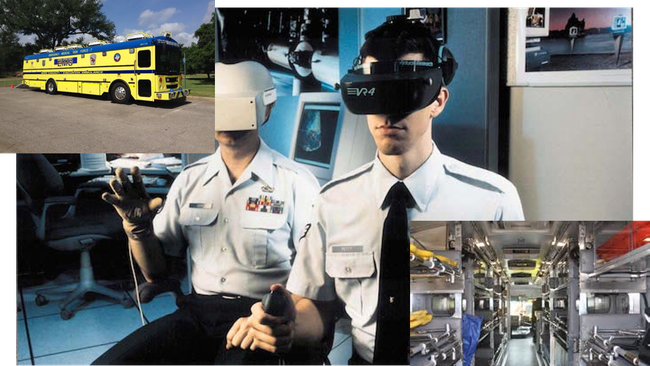EMS personnel called to work large scale emergencies work on a bus-sized ambulance, called an Ambus. Although they receive training once a year, sine emergencies happen rarely, the personnel are at risk of not being familiar with the operations of the Ambus system when they are called upon. Moreover, the EMS personnel are often needed very quickly so attending traditional, day long retraining activities is unrealistic.
The personnel are often distributed over a sizeable geographic region while the current training is a combination of class-room presentation and hands-on simulations.
We propose a virtual-reality (VR) application that can be delivered remotely to the distributed EMS personnel before they assemble, or as they are assembling. Such an application will better prepare them to be as effective as possible in using the life-saving features of the AmBus.
Lives may be saved and the severity of the injuries may be reduced because the EMS personnel are better prepared.
Virtual reality (VR) training is an emerging service using technologies that are getting cheaper and more accessible to organizations with constrained budgets. EMS technologies are getting more complex and, in the Ambus case, are often used without enough regularity to build "muscle memory" expertise with them. The strengths of VR ... almost real world simulation ... focused on a need for expertise where familiarity is hard to get and undesirable (who wants lots of mass casualty emergencies?) make this "next generation."
The team consists of Texas State University researchers and City of Austin staff members. The skill sets cover the different dimensions of the challenge:
1) EMS Disaster Operations
2) City of Austin IT and Data management and operations
3) Available VR technologies to build upon (CoA and Texas State)
4) Research expertise (by Austin residents and Texas State professors) in communication design and VR use cases.
5) Components of the project already have seed funding.
The members of the team are:
Marbenn Cayetano, It Business Systems Analyst Sr., City of Austin
Keith Noble, EMS Commander, City of Austin
Charles Purma, Mgr, Information Systems and Business Enterprises
Grayson Lawrence, Associate Professor, Communication Design, School of Art and Design, Texas State University
Scott Smith, Associate Professor, Director, Virtual Reality and Technology Lab, School of Social Work, Texas State University
Ted Lehr, IT Data Architect, City of Austin
Large scale disasters are generally not exclusive events. Preparing the EMS personnel to perform at their best or near-best will be a service to the under-served communities.
The curriculum development and testing will be led by the university researchers and their support staff and students. We have funding for some initial equipment or have existing laboratory and other equipment to build prototypes. We don't have funding for curriculum development and testing. We would use the funds for this implementation need. Perhaps, more importantly, we would use the additional funding to leverage further funding sources by showing that the concept has been endorsed and validated. The impact of the prize money would therefore be magnified through faster development or additional features for scaling and portability to other communities, thus positioning it commercialization through negotiated transfers. The additional funding might come from other government grants, from university matching funds, or from the private sector (we have been keeping Google Fiber apprised of our progress with the expectation of engaging them further once we have a supported proposal).
